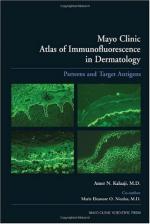|
This section contains 717 words (approx. 3 pages at 300 words per page) |

|
Immunofluorescence refers to the combination of an antibody and a compound that will fluoresce when illuminated by light of a specific wavelength. The duo is also referred to as a fluorescently labeled antibody. Such an antibody can be used to visually determine the location of a target antigen in biological samples, typically by microscopic observation.
The fluorescent compound that is attached to an antibody is able to absorb light of a certain wavelength, the particular wavelength being dependent on the molecular construction of the compound. The absorption of the light confers additional energy to the compound. The energy must be relieved. This is accomplished by the emission of light, at a higher wavelength (and so a different color) than the absorbed radiation. It is this release of radiant energy that is the underpinning for immunofluorescence.
Immunofluorescence microscopy can revel much detail about the processes inside cells. In a...
|
This section contains 717 words (approx. 3 pages at 300 words per page) |

|


